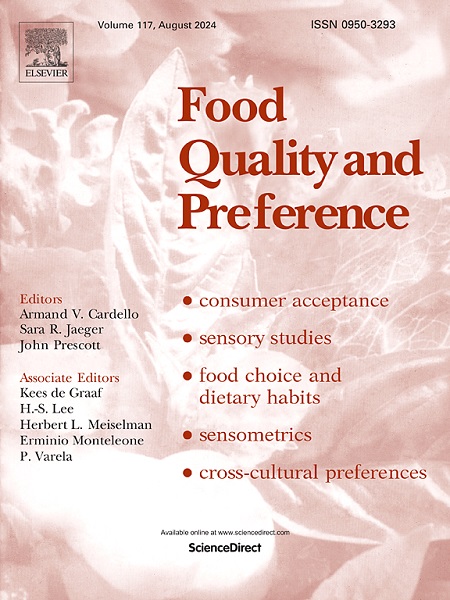在使用过程中捕捉化妆品面霜的感官和情感动态:一种时间优势方法
IF 4.9
1区 农林科学
Q1 FOOD SCIENCE & TECHNOLOGY
引用次数: 0
摘要
本研究旨在探讨产品使用过程中感觉和情绪反应之间的关系,利用感觉的时间优势(TDS)和情绪的时间优势(TDE)来捕捉使用面霜过程中感觉特性和情绪的时间演变。初步研究(研究A)采用EmoSemio产品特定问卷调查方案进行了20次定性访谈,以确定用于TDS评估的11个感官属性和用于TDE测试的11个情感属性。主要研究(研究B)对100名经常使用面霜的女性进行了评估,评估了五种市售的保湿面霜。TDS和TDE评估从最初的视觉和嗅觉评估到面霜的应用和应用后阶段。TDS和TDE曲线以及感觉-情绪轨迹显示了产品之间基于主导感官属性和情绪的差异。这些发现证明了TDS和TDE方法在描述化妆品面霜在一次使用过程中引起的感官特性和情绪演变方面的有效性,表明它们可能应用于其他产品类别。本文章由计算机程序翻译,如有差异,请以英文原文为准。
Capturing the sensory and emotional dynamics of cosmetic creams during usage: A temporal dominance approach
This study aimed to investigate the relationships between sensory and emotional responses during product application, using the Temporal Dominance of Sensations (TDS) and the Temporal Dominance of Emotions (TDE) to capture the temporal evolution of sensory properties and emotions during the use of facial creams. A preliminary study was conducted (Study A) carrying out 20 qualitative interviews following the EmoSemio product-specific questionnaire protocol to identify 11 sensory attributes for the TDS assessment and 11 emotional attributes for the TDE test. The main study (Study B) was conducted on 100 women who regularly use facial creams evaluating five commercially available moisturizing face creams. The TDS and TDE evaluations spanned from the initial visual and olfactory assessments to cream application and post-application phases.
TDS and TDE curves, and the sensory-emotional trajectories revealed differences between products based on their dominant sensory attributes and emotions. These findings demonstrate the effectiveness of TDS and TDE methods to describe the evolution of sensory properties and emotions elicited by cosmetic creams during a single usage, suggesting their potential application to other product categories.
求助全文
通过发布文献求助,成功后即可免费获取论文全文。
去求助
来源期刊

Food Quality and Preference
工程技术-食品科技
CiteScore
10.40
自引率
15.10%
发文量
263
审稿时长
38 days
期刊介绍:
Food Quality and Preference is a journal devoted to sensory, consumer and behavioural research in food and non-food products. It publishes original research, critical reviews, and short communications in sensory and consumer science, and sensometrics. In addition, the journal publishes special invited issues on important timely topics and from relevant conferences. These are aimed at bridging the gap between research and application, bringing together authors and readers in consumer and market research, sensory science, sensometrics and sensory evaluation, nutrition and food choice, as well as food research, product development and sensory quality assurance. Submissions to Food Quality and Preference are limited to papers that include some form of human measurement; papers that are limited to physical/chemical measures or the routine application of sensory, consumer or econometric analysis will not be considered unless they specifically make a novel scientific contribution in line with the journal''s coverage as outlined below.
 求助内容:
求助内容: 应助结果提醒方式:
应助结果提醒方式:


